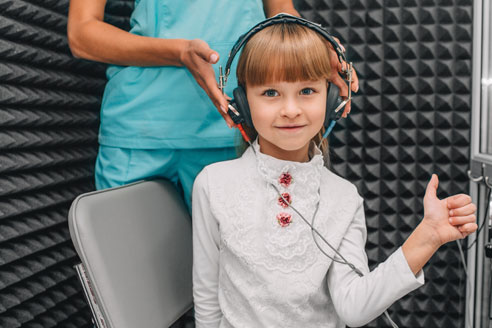Comprehensive hearing assessment can be completed at any age if there is any suspicion that a hearing problem exists. Hearing is not an all or nothing phenomena. Without direct testing, it is impossible to determine that a child hears perfectly across the range of frequencies necessary for understanding speech. Since speech consists of both low and high-pitched sounds, a hearing loss in one region can cause the child to misperceive speech. Even a slight or mild hearing loss, such as may occur with persistent inflammation or infection of the middle ear, during critical years for language and speech development may cause a delay in normal communication skills.

A hearing healthcare professional skilled in working with young children completes a comprehensive hearing assessment. The results of the test are recorded on an audiogram, a chart that measures how well an individual can hear. Results are used to determine the type of hearing disorder and whether hearing instruments are needed or whether medical or surgical treatment is required.
Conventional hearing tests usually require that the child respond in some way (verbally, by picture pointing, raising a hand, or through a “game”) to soft sounds produced by an audiometer. By the age of three, these types of tests are generally appropriate. For younger children, beginning at about six months of age, other behavioral hearing tests that reinforce a baby’s response to test sounds using an animated toy can be used accurately.
For younger infants, or for children who cannot reliably do behavioral test procedures, more objective tests can help determine hearing abilities. One is known as the Auditory Brainstem Response (ABR). Test signals (brief clicks or tonal “pips”) are sent to the child’s ears through microphones. Minute electrical responses produced by the cochlea in response to the test signals are recorded from the scalp using small disc electrodes. These are averaged by the computer and displayed as a wave form. The child must be sleeping quietly to record the ABR. The ABR can provide 1) an estimate of hearing sensitivity, and 2) information about the function of the auditory pathway to the level of the brainstem.
Other objective tests are also used in audiologic assessments. “Otoacoustic emissions” (OAEs) involve recording a “cochlear echo” in response to test signals. This provides further information on hair cell functioning in the cochlea.
Middle ear function can be examined through “acoustic admittance” testing, also known as “tympanometry,” that may help determine the presence of fluid behind the eardrum or aid in the diagnosis of middle ear problems. Eardrum movement is recorded in response to air pressure changes. The test is quick and painless.
Should your child have a hearing loss which cannot be treated medically or surgically, hearing healthcare professionals can provide various types of amplification to assist the child in hearing sound. Hearing instruments can be provided at any age.